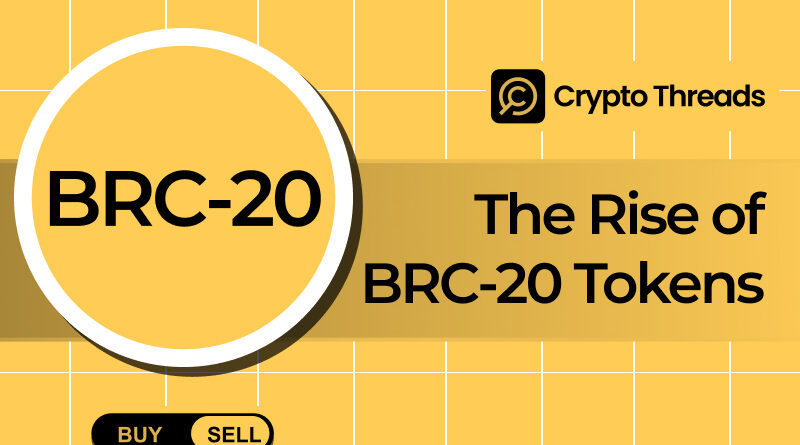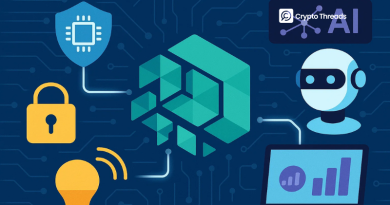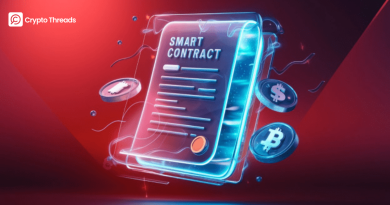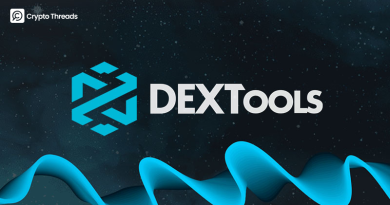The Rise of BRC-20 Tokens: What You Need to Know
Why BRC-20 Tokens Affect Bitcoin Transactions and Fees
The introduction of BRC-20 tokens has significantly impacted the Bitcoin blockchain by increasing the complexity of transactions and taking up more space in each block. Unlike standard Bitcoin transactions, which typically require minimal space (in kilobytes), creating and transferring BRC-20 tokens involves serial characters that can be up to 4 MB. This additional data load results in competition for limited space in Bitcoin blocks, increasing transaction fees, especially as users prioritize faster confirmations.
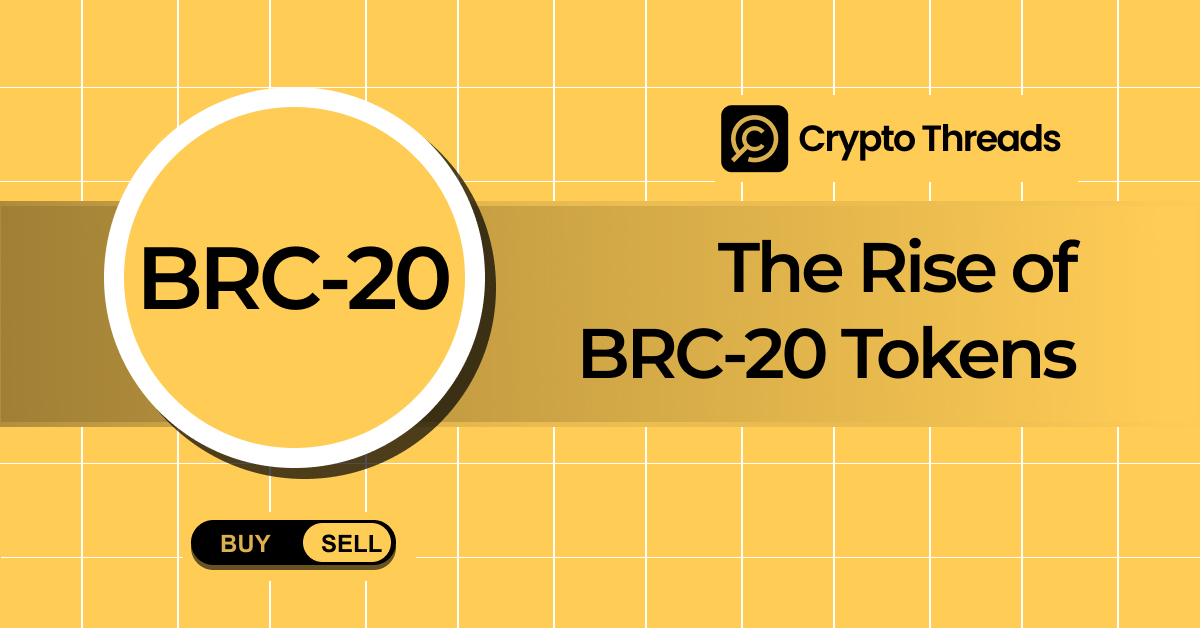
BRC-20 Tokens
The token differs significantly from Ethereum’s NFTs, as it embeds all of the token’s associated data—such as images, metadata, and instructions—directly on the Bitcoin blockchain. This is different from NFTs, which typically contain links to external storage. As a result, more data fills the blockchain, contributing to congestion and driving up transaction fees. This situation also affects Bitcoin’s mempool, where unconfirmed transactions wait to be processed, especially during times of high demand. In May, this caused exchanges like Binance to temporarily suspend withdrawals to adjust to fluctuating transaction fees.
Blockchain nodes that process these transactions are incentivized by the fees they collect. This supply-demand dynamic means that as transaction demand increases, fees also increase, especially for those who want to speed up transactions. Nodes play a vital role in maintaining the security and operational integrity of Bitcoin.
BRC-20 Token Applications
Peer-to-peer transfers are one of the primary applications of BRC-20 tokens, but there are many other possible applications. With fees paid in Bitcoin and transactions settled on the Bitcoin blockchain, these tokens allow for seamless value transfers between Bitcoin wallets. This is a powerful addition to Bitcoin’s existing framework, giving users more options to use the cryptocurrency for purposes other than simple payments. Additionally, BRC-20 tokens open the door to decentralized finance (DeFi)-related applications. BRC-20 tokens enable DeFi on the Bitcoin network, giving users more freedom and extending Bitcoin’s utility beyond traditional transactions, even as Ethereum continues to dominate the DeFi space.
Another promising use case for BRC-20 tokens is asset tokenization. Real-world assets such as real estate, stocks, and even precious metals can be tokenized with BRC-20 tokens, offering a new approach to wealth management and investing. By turning tangible assets into digital tokens, BRC-20 enables easier transfer and fractional ownership, opening up new opportunities for investment and asset distribution.
Differences When Comparing ERC-20 and BRC-20 Tokens
There are several key differences between BRC-20 and ERC-20 tokens. One of the most obvious differences is the use of different blockchains. The Ethereum blockchain serves as the platform for ERC-20 tokens, while the Bitcoin blockchain serves as the platform for BRC-20 tokens. This distinction is important because it illustrates the differences in programming languages, security approaches, and ecosystems between the two networks.
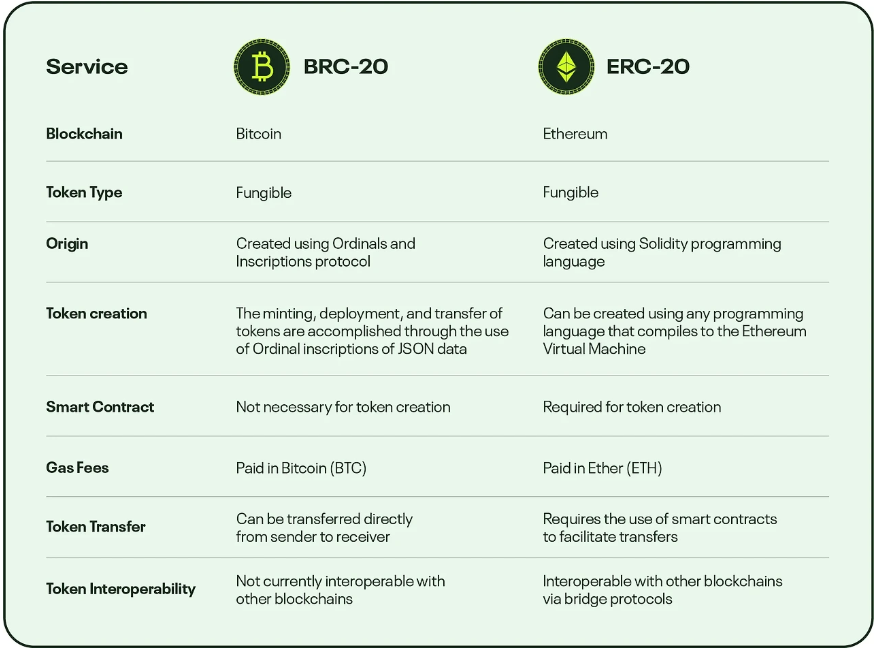
BRC-20 Tokens and ERC-20 Tokens (Source: ccn.com)
The way these tokens are created is also different. ERC-20 tokens are created using smart contracts, which are self-executing contracts with the terms of the agreement written directly into lines of code. In contrast, BRC-20 tokens are written to the Bitcoin blockchain via JSON files, which is a more manual process. This difference also affects how transactions are processed. Since BRC-20 transactions are processed based on the rules of the Bitcoin blockchain, they will be rejected if they do not meet the conditions specified in the profile.
Comparing BRC-20 Tokens to Other Cryptocurrencies
BRC-20 tokens have several advantages over other cryptocurrencies. One of the main benefits is cross-chain interoperability, which allows BRC-20 Tokens to operate seamlessly across multiple blockchain platforms. This increases their utility and extends their application beyond the Bitcoin network. Additionally, BRC-20 Tokens leverage advanced cryptographic techniques, providing a high level of security for transactions, which is an important feature for users concerned about the safety of their assets.
An additional benefit is that, compared to many other cryptocurrencies, BRC-20 tokens typically have lower fees. Therefore, they are a desirable choice for customers looking for more cost-effective transactions. A wide range of use cases, including asset tokenization, decentralized banking, and exchanges, are also supported by BRC-20 tokens. This adaptability increases their appeal as a versatile tool within the larger blockchain ecosystem. Bitcoin’s versatility in digital finance could also be enhanced by the prospect of its inclusion in decentralized financial systems. Despite these advantages, there are still reasons why some users may choose other cryptocurrencies over BRC-20 tokens.
Established cryptocurrencies like Bitcoin and Ethereum have much larger user bases, higher liquidity, and more infrastructure support, making them more practical for users who prioritize ease of use and accessibility. These blockchains also benefit from a wider exchange list, which can make trading more convenient. Additionally, Ethereum’s mature ecosystem provides developers with a more comprehensive set of tools and resources, allowing for greater flexibility and innovation in building decentralized applications.
BRC-20 Coin Scalability
The BRC-20 token market is expanding rapidly; there are currently over 14,000 different tokens in use, and their market cap is close to $1 billion. The ability to tokenize financial assets is likely to continue to grow as the BRC-20 development team works to enhance and expand the functionality of the token. BRC-20 tokens have proven that they can revolutionize traditional banking and open up new possibilities for decentralized applications, even if they are currently considered experimental. Given the immaturity and risk of the technology, investors should exercise caution even as continued progress promises to bring further improvements.
Trends Influencing the Future of BRC-20 Tokens
The future of BRC-20 tokens is expected to be shaped by a number of developments. The growing use of these tokens in various fields is one of the most important developments. The potential for improved transaction efficiency and transparency of BRC-20 tokens could lead to widespread use in areas such as supply chain management and banking. Interoperability between blockchain networks is expected to increase as these currencies become more popular, allowing for smoother transfers of tokens between platforms. This will improve liquidity and further integrate decentralized applications into traditional financial systems.
As the popularity of BRC-20 tokens increases, security will also become a top priority. Multi-layer authentication techniques and better encryption standards will be created to protect assets and transactions. In addition to helping secure BRC-20 tokens, this will help increase confidence in their deployment in broader contexts.
Future Forecast of BRC-20
Many sectors may undergo radical transformation in the future due to BRC-20 tokens. Among the sectors affected is the tokenization of physical products. By leveraging BRC-20 tokens to digitally represent real estate, goods, and intellectual property, ownership and transfer are partly simplified. Sectors of the economy that rely on these resources may be significantly impacted. The DeFi industry is also predicted to grow rapidly as BRC-20 tokens are added to lending, staking, yield farming, and decentralized exchanges, providing new financial capabilities and solutions.
Regulations will need to change as BRC-20 tokens evolve to address their unique features. This will ensure that BRC-20 tokens comply with existing regulations while encouraging further advancements in the digital asset space.
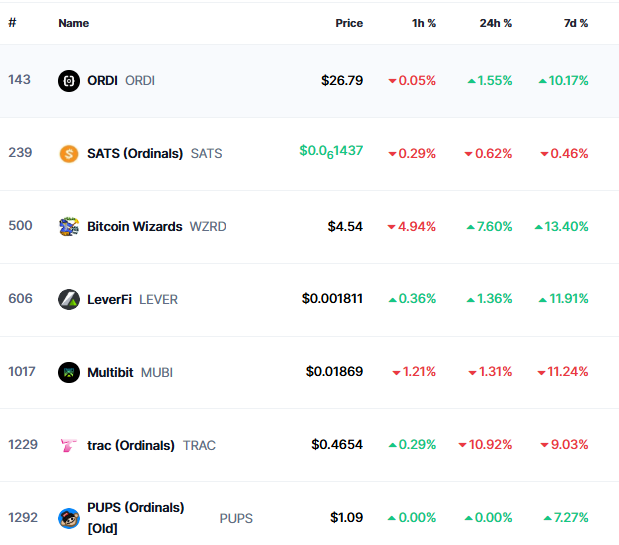
Some BRC-20 tokens (Source: https://coinmarketcap.com)
There are some noteworthy BRC-20 tokens that have been popular in the marketplace. A popular BRC-20 token for creating NFTs that are recorded on the Bitcoin blockchain is called ORDI. The cryptocurrency has been popular because of its unique strategy and is now listed on Binance. A well-known token that is comparable to BRC-20 tokens in many ways, including its decentralized community and blockchain operations, is DODGE. The BRC-20 ecosystem’s meme-based currency, AINN, is dedicated to community-driven development and Web3 exploration, particularly in AI-powered apps.
Other tokens like SATS, a tribute to the smallest unit of Bitcoin (satoshi), and TRAC (OriginTrail), a decentralized infrastructure for AI-powered solutions, are also making waves. These tokens offer unique utility, contributing to the diversification and expansion of the BRC-20 ecosystem.
